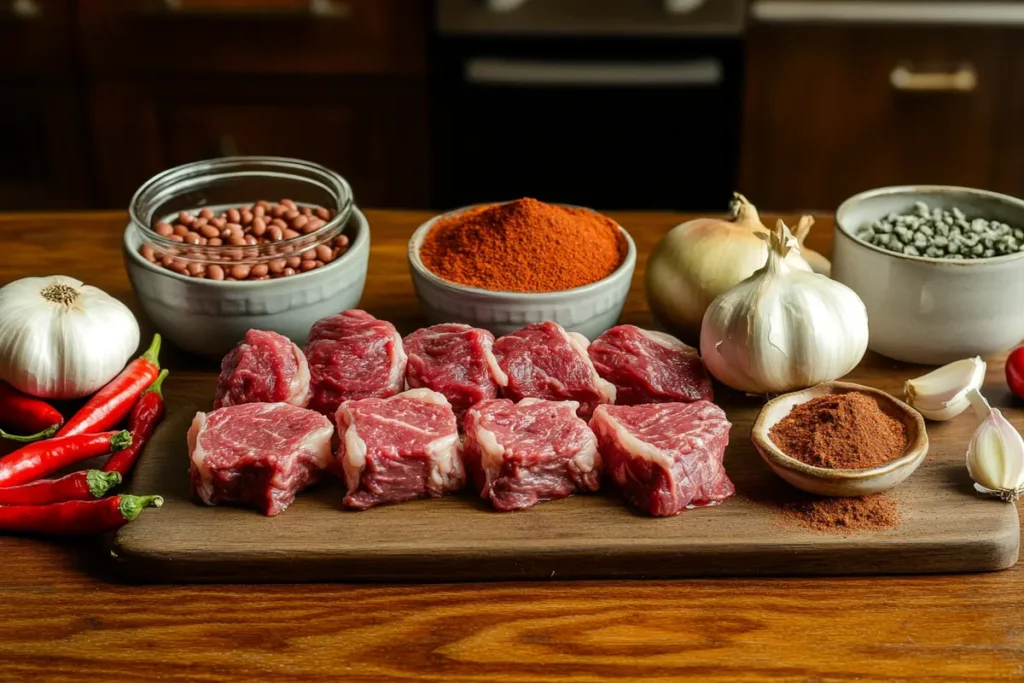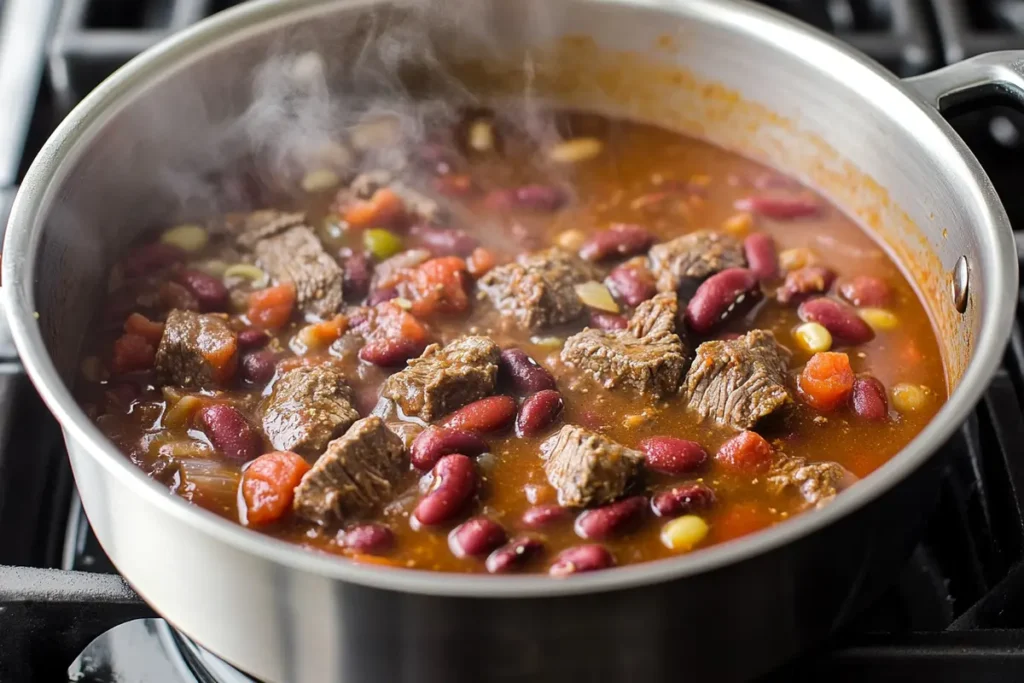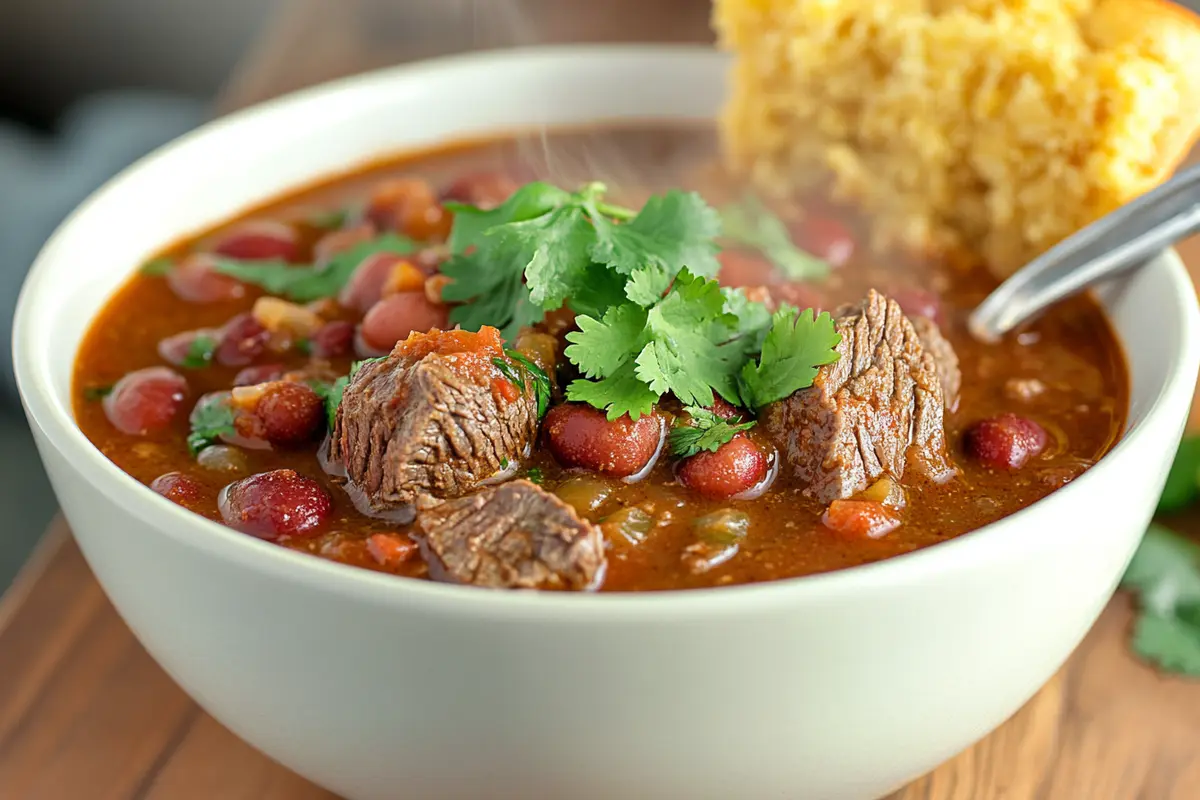There’s nothing quite like a steaming bowl of chili to satisfy cravings and warm the soul. This ultimate steak and beef chili recipe blends the tender, juicy texture of steak with the richness of ground beef, delivering bold flavors that will make you the star of any gathering. In this guide, we’ll explore every step of creating this hearty dish, from selecting the perfect ingredients to serving it with the best accompaniments. Whether you’re cooking for a family dinner or a potluck, this recipe will surely delight!
Introduction to Steak and Beef Chili
The Popularity of Chili Dishes
Chili is the ultimate comfort food. Its rich, hearty flavors and customizable nature have secured its place as a household favorite worldwide. From its origins in the American Southwest to its countless variations, chili has evolved into a dish that offers something for everyone. The combination of smoky spices, tender meat, and savory beans creates a harmonious blend that satisfies on every level.
Why Choose a Steak and Beef Combination?
If you’ve been sticking to traditional ground beef chili, it’s time to shake things up. Using both steak and ground beef in your chili introduces a game-changing texture and depth of flavor. Steak provides tender, juicy bites, while ground beef ensures the chili remains hearty and satisfying. This duo creates a balance that will impress even the most discerning palates. Plus, it’s versatile—you can adjust the spice level and ingredients to suit your taste buds.
By combining these two types of beef, the chili develops layers of complexity, where every bite brings a new surprise. You’ll notice a richness that’s unmatched, with each ingredient complementing the other. It’s a perfect marriage of bold flavors and hearty goodness that makes this recipe stand out.
Understanding the Ingredients
Key Ingredients for Steak and Beef Chili
Creating the perfect steak and beef chili starts with understanding the importance of each ingredient. From the cuts of meat to the spices, every component plays a role in delivering a dish that’s bold, hearty, and unforgettable.
Selecting the Right Cuts of Beef
Recommended Steak Cuts
The steak you choose for your chili should be tender yet flavorful. Cuts like chuck steak or sirloin are excellent choices due to their marbling and ability to stay tender during slow cooking. Trim excess fat, but don’t discard it entirely—fat adds richness to your chili.
Choosing Ground Beef
For ground beef, aim for an 80/20 blend. The higher fat content adds moisture and flavor, ensuring your chili is never dry. If you prefer leaner options, consider adding a splash of olive oil during cooking to maintain that hearty texture.
Essential Vegetables and Aromatics
Onions and Garlic
No chili recipe is complete without onions and garlic. These two aromatics lay the foundation for flavor. Yellow onions are a classic choice, while red onions offer a sweeter bite. Garlic, when minced or crushed, adds depth and a slightly nutty aroma.
Peppers and Chilies
Bell peppers and chili peppers bring color, flavor, and heat. Use red and green bell peppers for their natural sweetness and mild crunch. For heat, jalapeños or serrano peppers are ideal. Feeling adventurous? Try a pinch of smoked paprika or chili flakes for an extra kick.
Spices and Seasonings
Chili Powder and Cumin
Chili powder is the heart of this recipe. It’s a blend of spices that creates the warm, smoky undertone chili is known for. Cumin adds an earthy, nutty aroma, tying all the flavors together beautifully.
Additional Herbs and Spices
Other key spices include paprika, garlic powder, and oregano. Want a touch of sweetness to balance the heat? Add a hint of cinnamon or cocoa powder—both work wonders in enhancing the dish’s complexity.
Beans and Legumes
Kidney Beans
Kidney beans are a traditional choice for chili due to their firm texture and ability to absorb flavors without turning mushy. They also provide a nice contrast to the meat.
Alternative Bean Options
For a twist, consider black beans or pinto beans. Both offer slightly different textures and flavors that can elevate your chili. Prefer a bean-free chili? No problem—simply skip this step and let the meat shine as the star.

Preparation Steps
Preparing the Meat
The foundation of a great steak and beef chili lies in how you handle the meat. Proper preparation not only enhances the flavor but also ensures the texture is just right.
Trimming and Cutting the Steak
Start by trimming any excess fat from your steak. While some fat is beneficial for flavor, too much can make the chili greasy. Cut the steak into bite-sized cubes, around 1-inch each, to ensure even cooking. For best results, lightly season the steak cubes with salt and pepper before browning.
Browning the Ground Beef
In a large skillet or heavy-bottomed pot, heat a tablespoon of oil over medium-high heat. Add the ground beef in batches, so it sears evenly without steaming. Browning creates caramelized bits, which add a rich depth of flavor to the chili. Use a wooden spoon to break up the beef as it cooks.
Pro Tip: After browning, deglaze the pan with a splash of beef broth. This lifts the flavorful browned bits (fond) from the bottom, ensuring none of the goodness goes to waste.
Sautéing the Vegetables
To develop a robust flavor base, sauté the vegetables and aromatics next.
Achieving the Right Texture
In the same pot, add diced onions, minced garlic, and chopped bell peppers. Cook them over medium heat until they’re soft and fragrant. Stir frequently to avoid burning the garlic, which can make the chili taste bitter. If you’re using chili peppers for heat, add them now to allow their oils to infuse into the mix.
Combining Ingredients
Layering Flavors
Once the vegetables are ready, it’s time to build layers of flavor. Add the browned ground beef and steak cubes back into the pot. Sprinkle in your chili powder, cumin, smoked paprika, and oregano. Stir well to coat every ingredient in the aromatic spices.
Adjusting Consistency with Broth
Pour in beef broth, canned diced tomatoes, and tomato paste. Stir to combine, ensuring no lumps remain. If the chili seems too thick, add a splash more broth, but remember—it will thicken as it simmers. For added richness, include a can of drained and rinsed kidney or black beans if desired.
Cooking Techniques
Cooking Methods for Chili
To cook steak and beef chili to perfection is all about patience and the right technique. Whether you prefer the stovetop, slow cooker, or Instant Pot, each method ensures your chili develops rich, deep flavors.
Stovetop Method
The stovetop method is classic and straightforward. It allows for full control over the cooking process, ensuring you can tweak flavors as you go.
Simmering Time and Temperature
- Once all ingredients are combined, bring the mixture to a gentle boil over medium heat.
- Reduce the heat to low and let it simmer uncovered for 1.5 to 2 hours, stirring occasionally to prevent sticking.
- As it simmers, the flavors meld, and the sauce thickens. If the chili becomes too thick, add a bit of beef broth or water to adjust the consistency.
Slow Cooker Method
For those who love set-it-and-forget-it meals, the slow cooker is a game-changer. This method allows the chili to cook low and slow, intensifying the flavors effortlessly.
Setting and Duration
- After browning the meat and sautéing the vegetables, transfer everything into a slow cooker.
- Add the beans, spices, and liquids, then give it a good stir.
- Cook on low for 6 to 8 hours or on high for 3 to 4 hours.
The slow cooking process tenderizes the steak and allows the spices to fully infuse into the meat and beans, delivering an incredibly hearty dish.
Instant Pot Method
When you’re short on time but still crave the richness of slow-cooked chili, the Instant Pot steps in to save the day.
Pressure Cooking Instructions
- Use the sauté function to brown the ground beef and steak directly in the Instant Pot. Remove and set aside.
- Sauté the vegetables, then return the meat to the pot. Add the spices, beans, and liquids, stirring to combine.
- Secure the lid and set the Instant Pot to pressure cook on high for 25 minutes. Allow the pressure to release naturally for 10 minutes before opening.
This method locks in the flavors while cutting the cooking time dramatically.

Enhancing Flavor
Tips for a Flavorful Chili
To make your steak and beef chili unforgettable, it’s not just about the ingredients but also the techniques and small enhancements that elevate every bite. Let’s explore some expert tips to bring out the best flavors in your chili.
Importance of Deglazing
Deglazing is a crucial step that adds depth to your chili. When you brown the meat or sauté vegetables, flavorful bits (fond) stick to the bottom of the pot. Before adding your liquids, pour a splash of beef broth or water into the pot and scrape up these bits with a wooden spoon. This process intensifies the chili’s overall flavor profile.
Utilizing Umami Boosters
Adding umami-rich ingredients can take your chili to new heights, making the flavors more robust and satisfying.
Adding Cocoa Powder or Coffee
- A teaspoon of unsweetened cocoa powder introduces a subtle richness and depth to the chili without overpowering it.
- For a more complex flavor, a small shot of brewed coffee or espresso works wonders in balancing the dish’s savory elements.
Pro Tip: Don’t worry about these ingredients making the chili taste like chocolate or coffee—they simply enhance the meaty flavors.
Balancing Heat and Sweetness
A well-balanced chili is one where the heat doesn’t overpower the other flavors, and sweetness complements the spice.
Adjusting Spice Levels
- For a milder chili, remove the seeds from your chili peppers before adding them.
- To increase the heat, add a pinch of cayenne or diced serrano peppers.
Incorporating Sweeteners
A touch of sweetness helps balance the bold, smoky spices. Add a tablespoon of honey, brown sugar, or even a small amount of molasses. These sweeteners round out the flavors and soften any bitterness from the tomatoes.
Serving Suggestions
Serving Your Steak and Beef Chili
Now that your steak and beef chili has simmered to perfection, it’s time to think about presentation and accompaniments. Serving chili with thoughtful sides and toppings enhances the dining experience, turning a hearty meal into a memorable one.

Ideal Accompaniments
Pairing the right sides with your chili makes all the difference. These accompaniments add variety in texture and flavor, complementing the richness of the dish.
Cornbread and Tortilla Chips
- A slice of warm, buttery cornbread is the perfect partner for chili, soaking up the rich sauce beautifully.
- Crispy tortilla chips provide a satisfying crunch and are great for scooping up the chili.
Rice or Quinoa
For a more substantial meal, serve the chili over a bed of steamed rice or quinoa. These grains help mellow out the spice while adding a wholesome element.
Vegetable Sides
A simple green salad or steamed vegetables, like broccoli or green beans, adds a refreshing contrast to the bold flavors of the chili.
Topping Ideas
Toppings transform chili into a customizable masterpiece, letting each person tailor their bowl to their taste.
Cheese, Sour Cream, and Herbs
- A generous sprinkle of shredded cheddar or Monterey Jack cheese melts into the chili, adding a creamy richness.
- A dollop of sour cream cools down the spice while introducing a tangy note.
- Freshly chopped cilantro or parsley adds a burst of color and a refreshing herbal finish.
Avocado and Lime Wedges
For a fresh, zesty twist, garnish with avocado slices and serve with lime wedges. The lime juice brightens the dish, balancing the smoky spices beautifully.
Presentation Tips
Serve your chili in rustic bowls to emphasize its hearty nature. Set up a topping bar with small bowls of garnishes, so guests can personalize their meal. Don’t forget to include plenty of napkins it’s a dish meant to be enjoyed wholeheartedly!
Storage and Reheating
Proper Storage Techniques
One of the best things about steak and beef chili is how well it keeps, making it an ideal make-ahead meal or option for leftovers. Proper storage preserves the flavors and ensures food safety.
Refrigeration Guidelines
- Allow the chili to cool to room temperature before storing. This prevents condensation, which could make the chili watery.
- Transfer the chili to an airtight container. Properly sealed containers prevent odor transfer and keep your chili fresh.
- Store in the refrigerator for up to 4 days. Ensure the chili stays at or below 40°F to maintain its quality.
Freezing Instructions
Chili freezes beautifully, making it a perfect meal to prepare in bulk.
- Divide the chili into portion-sized containers or freezer-safe bags for convenience.
- Label the containers with the date for easy tracking. Frozen chili can last up to 3 months.
- When using freezer bags, lay them flat to save space and allow for quicker thawing.
Pro Tip: Freeze the chili without toppings like cheese or sour cream. Add these fresh after reheating for the best results.
Reheating Methods
Reheating chili is simple, but doing it right ensures the flavors and textures remain intact.
Maintaining Flavor and Texture
- Stovetop: Place the chili in a pot and heat over medium-low, stirring occasionally. Add a splash of water or beef broth if it’s too thick.
- Microwave: Heat in a microwave-safe bowl, covered, at 70% power in 1-minute intervals. Stir between intervals to ensure even heating.
- Oven: For larger portions, reheat in an oven-safe dish covered with foil at 350°F for about 20 minutes.
With proper storage and reheating, your steak and beef chili remains as delicious as the day it was made. Whether you’re enjoying it on a busy weeknight or as a quick meal from the freezer, this dish proves to be a versatile and satisfying option.
Frequently Asked Questions
Can I use different types of beans?
Absolutely! While kidney beans are traditional, black beans, pinto beans, or even chickpeas are excellent substitutes. Each type adds its unique flavor and texture to the dish. You can also mix and match beans for variety.
How can I make the chili spicier or milder?
To spice things up, add diced jalapeños, serrano peppers, or a pinch of cayenne. For a milder version, use sweet bell peppers instead of hot chilies and reduce the chili powder. Removing seeds from hot peppers also helps tone down the heat.
Is it necessary to use both steak and ground beef?
No, but the combination is what makes this recipe special! The steak adds hearty chunks and a satisfying chew, while the ground beef ensures the chili remains rich and thick. If you prefer one over the other, feel free to adjust according to your taste.
What are some vegetarian alternatives?
If you’re catering to vegetarians, replace the beef with plant-based crumbles or additional beans. Add mushrooms for a meaty texture, and don’t skimp on the spices to maintain the bold chili flavor.
Conclusion
This steak and beef chili recipe is the perfect blend of tender steak, hearty ground beef, bold spices, and rich flavors. Whether simmered slowly or cooked quickly, it’s a versatile, crowd-pleasing dish that’s easy to customize and even easier to love. Pair it with your favorite sides and toppings, and enjoy a comforting meal that’s as satisfying as it is delicious. Happy cooking! 🌟

